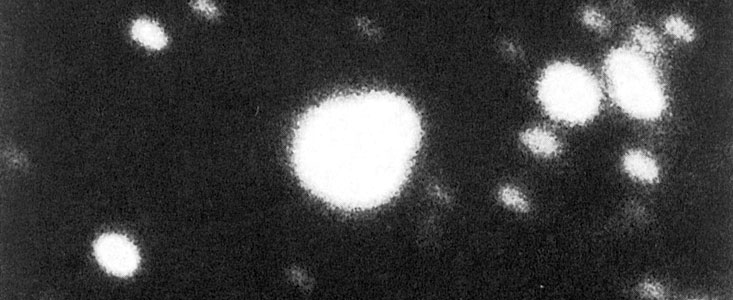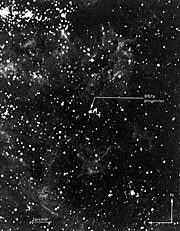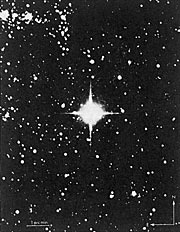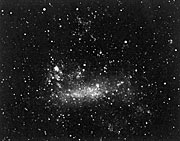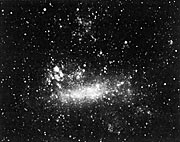Pressemitteilung
Supernova in Large Magellanic Cloud: Overview of First Results
3. März 1987
One week after the explosion of a bright supernova (1987A) in the Large Magellanic Cloud (ESO 04/87), and after intensive observations at the European Southern Observatory and elsewhere in the southern hemisphere, it is now possible to draw several important conclusions about this unique event.
The supernova is located about 20 arcminutes (2/3 of the diameter of the Moon), southwest of the well-known Tarantula Nebula, a bright gaseous nebula in the Large Magellanic Cloud. It was first seen early on February 24 by I. Shelton at the University of Toronto station at the Las Campanas Observatory in Chile. Subsequent inspection of a colour photo, by chance obtained at the European Southern Observatory on February 23, 01:00 Universal Time (UT) did not show the supernova, but it is clearly seen on photos taken 8 hours later in Australia. The explosion must therefore have taken place during this time interval.
The star that exploded (the supernova progenitor) has been provisionally identified with a 12th magnitude, hot supergiant star with the designation Sanduleak -69 202. Close examination of earlier photographs have revealed that this star has two very close companions. From positional measurements, it is seen that one of these (2.5 arcseconds northwest of the main star) cannot be the progenitor. However, the other companion is less than 1 arcsecond from the main star and it is not yet possible to decide which of the two became the supernova.
The brightness of the supernova continued to rise for several days after the initial, rapid phase. On February 25, the visual magnitude was 4.5, and two days later, it had reached 4.3. But accurate photometric measurements from the last days indicate stagnation or even a slight decrease, so that it appears that the maximum in visual light may have been reached around February 28. This would imply a total increase of about 8 - 9 magnitudes, or that the supernova is about 2000 times brighter in visual light than its progenitor. This may seem much, but is nevertheless unexpectedly little for a supernova of Type II. As a matter of fact, had this supernova behaved as other Type II supernovae, it would have been expected to reach magnitude +1, about as much as the brightest stars. This has already led to theoretical speculations and again demonstrates that the supernova phenomenon is far from being fully understood.
The colour of 1987A has become significantly redder since it was first observed. From the time of discovery until now, there has been a continuous, rather rapid decrease of the ultraviolet radiation, and somewhat less of the blue. Contrarily, the object has brightened in the red and infrared. This effect is explained by the decreasing temperature. Infrared photometry on March 2 shows that the temperature of the emitting material at this time was about 6000 degrees.
Immediately after discovery, spectra of medium resolution were rather featureless and showed no identifiable spectral lines, but later several broad spectral features have become visible. They are first of all the Balmer lines of hydrogen, which exhibit blue-shifted absorption and red-shifted emission features. This is typical for a Type II supernova and is due to emission from a rapidly expanding shell of material around the exploding star. The expansion velocity is around 17.400 km/sec. Rapid changes of this spectrum have been observed at ESO, probably reflecting violent motions in the surrounding gas.
Infrared spectra were obtained on March 1 with the ESO 1m photometric telescope. This is the first time that such spectra of a supernova have ever become available. Many emission lines are seen, including those of hydrogen and helium and the time-consuming interpretation of these spectra has now started at ESO.
Very high dispersion spectra were obtained with the ESO Coudé Echelle Spectrograph at the CAT telescope. They show - also for the first time - a large number of narrow absorption lines, which originate in interstellar clouds in the LMC and in our Galaxy (the Milky Way), and also in intergalactic clouds between the two galaxies. More than 20 such lines belong to ionized Calcium, around 13 to neutral Sodium and 2 to neutral Potassium. This unique observation will allow a study, for instance of the chemical composition of these clouds.
A search was made for very rapid variations in brightness (flickering) to see whether a rapidly rotating neutron star could be detected. It is known that such stars are left-overs by other supernovae and they are observed as pulsars. These objects are extremely dense; a mass similar to that of the Sun is contained within a diameter of 20 kilometres or less. Ultra-fast photometry at ESO of supernova 1987A has not yet detected such variations, but as the envelope expands, the possibilities for a successful search become larger.
In view of this extraordinary event, the telescope schedules at ESO La Silla were changed and all observers switched over to the supernova with great enthusiasm. Preliminary reports with more details than those given in the present Press Release will be published in the March issue of ESO's journal The Messenger. It is also expected that several articles will appear shortly in the scientific journals. A scientific Workshop on "Supernova 1987A in the LMC'' (Observations and Theory) will be held at the ESO Headquarters in Garching during early September 1987.
In the last decades, supernovae have been observed in other galaxies which were always more than one hundred times fainter than this one in the LMC. While studies made with large telescopes at ESO La Silla and elsewhere have yielded interesting data, no very high resolution studies were possible due to lack of light. However, with the full light gathering power of the future 16 m ESO Very Large Telescope (ESO Press Release eso8609), now being planned, fainter supernova in other galaxies, as well as some stars in the LMC will be observed with the same spectroscopic resolution as has been possible for supernova 1987A in LMC. This supernova thereby gives us a preview of the discoveries that can be made with the Very Large Telescope.
This Press Release is accompanied by three pictures:
B/W photo from 1977 showing the sky area of the supernova event, with the progenitor indicated,
B/W photo from 25 February 1987 of the same area and with the same scale, now showing the very bright supernova, and
Colour picture of the LMC, obtained on 25 February 1987, and clearly showing the entire LMC galaxy and the supernova near the Tarantula Nebula.
Additional pictures may become available from ESO at a later date. Copies of the March 1987 Messenger issue will be sent on request after March 15.
Kontaktinformationen
Richard West
ESO
Garching, Germany
Tel: +49 89 3200 6276
E-Mail: information@eso.org
Über die Pressemitteilung
| Pressemitteilung Nr.: | eso8705 |
| Legacy ID: | PR 05/87 |
| Name: | Large Magellanic Cloud, LMC, SN 1987A |
| Typ: | Local Universe : Star : Evolutionary Stage : Supernova |
| Facility: | Danish 1.54-metre telescope, ESO 1-metre Schmidt telescope, ESO 3.6-metre telescope |
Our use of Cookies
We use cookies that are essential for accessing our websites and using our services. We also use cookies to analyse, measure and improve our websites’ performance, to enable content sharing via social media and to display media content hosted on third-party platforms.
ESO Cookies Policy
The European Organisation for Astronomical Research in the Southern Hemisphere (ESO) is the pre-eminent intergovernmental science and technology organisation in astronomy. It carries out an ambitious programme focused on the design, construction and operation of powerful ground-based observing facilities for astronomy.
This Cookies Policy is intended to provide clarity by outlining the cookies used on the ESO public websites, their functions, the options you have for controlling them, and the ways you can contact us for additional details.
What are cookies?
Cookies are small pieces of data stored on your device by websites you visit. They serve various purposes, such as remembering login credentials and preferences and enhance your browsing experience.
Categories of cookies we use
Essential cookies (always active): These cookies are strictly necessary for the proper functioning of our website. Without these cookies, the website cannot operate correctly, and certain services, such as logging in or accessing secure areas, may not be available; because they are essential for the website’s operation, they cannot be disabled.
Functional Cookies: These cookies enhance your browsing experience by enabling additional features and personalization, such as remembering your preferences and settings. While not strictly necessary for the website to function, they improve usability and convenience; these cookies are only placed if you provide your consent.
Analytics cookies: These cookies collect information about how visitors interact with our website, such as which pages are visited most often and how users navigate the site. This data helps us improve website performance, optimize content, and enhance the user experience; these cookies are only placed if you provide your consent. We use the following analytics cookies.
Matomo Cookies:
This website uses Matomo (formerly Piwik), an open source software which enables the statistical analysis of website visits. Matomo uses cookies (text files) which are saved on your computer and which allow us to analyze how you use our website. The website user information generated by the cookies will only be saved on the servers of our IT Department. We use this information to analyze www.eso.org visits and to prepare reports on website activities. These data will not be disclosed to third parties.
On behalf of ESO, Matomo will use this information for the purpose of evaluating your use of the website, compiling reports on website activity and providing other services relating to website activity and internet usage.
Matomo cookies settings:
Additional Third-party cookies on ESO websites: some of our pages display content from external providers, e.g. YouTube.
Such third-party services are outside of ESO control and may, at any time, change their terms of service, use of cookies, etc.
YouTube: Some videos on the ESO website are embedded from ESO’s official YouTube channel. We have enabled YouTube’s privacy-enhanced mode, meaning that no cookies are set unless the user actively clicks on the video to play it. Additionally, in this mode, YouTube does not store any personally identifiable cookie data for embedded video playbacks. For more details, please refer to YouTube’s embedding videos information page.
Cookies can also be classified based on the following elements.
Regarding the domain, there are:
- First-party cookies, set by the website you are currently visiting. They are stored by the same domain that you are browsing and are used to enhance your experience on that site;
- Third-party cookies, set by a domain other than the one you are currently visiting.
As for their duration, cookies can be:
- Browser-session cookies, which are deleted when the user closes the browser;
- Stored cookies, which stay on the user's device for a predetermined period of time.
How to manage cookies
Cookie settings: You can modify your cookie choices for the ESO webpages at any time by clicking on the link Cookie settings at the bottom of any page.
In your browser: If you wish to delete cookies or instruct your browser to delete or block cookies by default, please visit the help pages of your browser:
Please be aware that if you delete or decline cookies, certain functionalities of our website may be not be available and your browsing experience may be affected.
You can set most browsers to prevent any cookies being placed on your device, but you may then have to manually adjust some preferences every time you visit a site/page. And some services and functionalities may not work properly at all (e.g. profile logging-in, shop check out).
Updates to the ESO Cookies Policy
The ESO Cookies Policy may be subject to future updates, which will be made available on this page.
Additional information
For any queries related to cookies, please contact: pdprATesoDOTorg.
As ESO public webpages are managed by our Department of Communication, your questions will be dealt with the support of the said Department.
